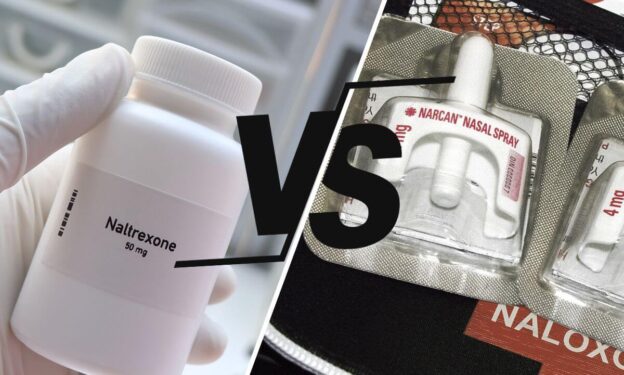In the midst of the opioid crisis, there’s been a lot of talk about treatments and emergency interventions. Two medications that often come up in these discussions are naltrexone and naloxone. Though their names sound similar, and they both interact with opioid receptors in the brain, their uses in the management of opioid dependence and overdose are distinct. In this blog, we’ll clarify the differences between naltrexone and naloxone, their uses, and how they function.
Naltrexone: The Recovery Assistant
Naltrexone is a medication that serves as an opioid antagonist, meaning it blocks the effects of opioids. It’s used primarily in the management of opioid addiction and is available in two forms: a pill that’s taken daily (known commercially as ReVia or Depade) and an extended-release injectable form given once a month (known as Vivitrol).
The primary role of naltrexone is to maintain abstinence in individuals who have already been detoxified from opioids. It achieves this by binding to the same receptors that opioids would, without activating them. This prevents any euphoria or high should the person relapse and use opioids. Unlike treatments such as methadone or buprenorphine, which are partial opioid agonists, naltrexone doesn’t have addictive properties, making it an appealing option for those seeking a medication-assisted treatment without the risk of physical dependency.
Naloxone: The Life Saver
Naloxone, in contrast, is an emergency medication designed to rapidly reverse opioid overdose. Known under the brand name Narcan among others, naloxone works by knocking opioids off the receptors in the brain. It’s typically administered when an individual exhibits signs of an overdose, such as difficulty breathing or loss of consciousness.
For over 26 years, people from all over the world have chosen Waismann Method as their opioid detox provider.
We know the challenges you face and the importance of creating a unique and personal experience for you right from the start.Call for Detox Options 1-800-423-2482
Naloxone’s action is almost immediate and can be life-saving, restoring breathing and consciousness. However, it’s short-acting, and the effects of the opioids may outlast the naloxone, sometimes making multiple doses necessary during an overdose event. Due to its importance in reversing overdoses, naloxone has been made more readily available to the public and first responders in many areas, often without the need for a prescription.
The Critical Differences
While both naltrexone and naloxone are opioid antagonists, their time to onset and duration of action differ significantly. Naltrexone has a more prolonged effect, making it suitable for daily or monthly use to prevent opioid relapse. Naloxone acts within minutes but has a much shorter duration, which is why it’s perfect for emergency overdose treatment but not for long-term management of opioid dependence.
Naltrexone or Vivitrol after Rapid Detox
For those who have gone through the Waismann Method, the subsequent choice between naltrexone or Vivitrol depends on individual circumstances, medical history, and personal preference. Naltrexone, in its oral form, requires daily commitment and adherence, which can be challenging for some. Vivitrol, as an extended-release injectable, offers the convenience of a once-a-month treatment, removing the daily decision to take a pill and helping to maintain the protective blockade against opioids.
Both naltrexone and Vivitrol act as safety nets, reducing the risk of relapse by blunting the effect of opioids. Their role post- rapid detox is to support the patient in building a new life free from opioid dependence. By preventing the high associated with opioid use, these medications allow individuals in recovery to focus on rehabilitation and the various therapies that form the foundation of a new, sober lifestyle.
Safety Profiles and Accessibility
Both medications are generally safe, but their introduction to a patient’s treatment plan should be carefully timed. Administering naltrexone too soon after opioid use can precipitate withdrawal, while naloxone can cause an immediate and sometimes severe withdrawal in a person with opioid dependence. Despite this, the risk-to-benefit ratio of naloxone is highly favorable, considering its ability to prevent death from overdose.
Regarding availability, while naloxone has seen widespread distribution, naltrexone is typically accessed through healthcare providers, with the injectable form often requiring a visit to a healthcare facility for administration.
The Path to Recovery and Beyond
Ultimately, naltrexone and naloxone both play critical roles in opioid addiction treatment and emergency care. Understanding the differences between the two is essential for individuals, loved ones, healthcare providers, and communities affected by the opioid epidemic. As part of a comprehensive treatment plan, including therapy and support systems, naltrexone can help maintain sobriety, while naloxone remains a critical tool in the fight against the immediate threat of overdose.
With ongoing research and policy support, these medications can significantly impact the lives of individuals struggling with opioid dependence and the communities striving to support them. As awareness and understanding grow, so does hope for recovery and a future free from addiction.
Sources:
- How Naltrexone Works
- What Are the Risks of Taking Vivitrol?
- Craving in Opioid Use Disorder
- The Neurobiology of Opioid Dependence
- Is Rapid Detox Dangerous?
This article, authored and reviewed by Clare Waismann, M-RAS, SUDCC II, Founder of Waismann Method Advanced Treatment for Opiate Dependence, is for informational purposes only and should not be considered medical advice or a recommendation. Consult a healthcare professional for guidance and treatment options. While we strive to maintain high editorial standards, please be aware that information may become outdated. Waismann Method, its employees, agents, and associated individuals are not liable for any errors, omissions, or consequences resulting from the use of the information provided.
** The blog is intended for informational purposes only and should not be considered medical advice. Always consult with a healthcare professional for medical advice and treatment.






